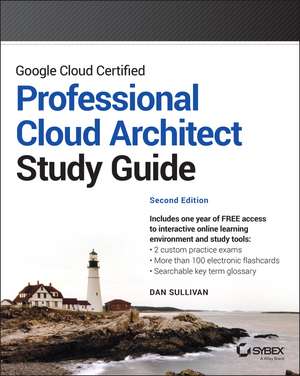Google Cloud Certified Professional Cloud Architect Study Guide, 2nd Edition: Sybex Study Guide
Autor D Sullivanen Limba Engleză Paperback – 27 apr 2022
Din seria Sybex Study Guide
- 20%
 Preț: 204.34 lei
Preț: 204.34 lei - 20%
 Preț: 204.48 lei
Preț: 204.48 lei -
 Preț: 416.00 lei
Preț: 416.00 lei - 20%
 Preț: 204.15 lei
Preț: 204.15 lei -
 Preț: 260.97 lei
Preț: 260.97 lei - 20%
 Preț: 272.31 lei
Preț: 272.31 lei - 20%
 Preț: 467.73 lei
Preț: 467.73 lei - 20%
 Preț: 343.55 lei
Preț: 343.55 lei - 20%
 Preț: 205.15 lei
Preț: 205.15 lei - 20%
 Preț: 289.38 lei
Preț: 289.38 lei - 20%
 Preț: 272.52 lei
Preț: 272.52 lei -
 Preț: 322.04 lei
Preț: 322.04 lei - 20%
 Preț: 304.02 lei
Preț: 304.02 lei -
 Preț: 404.31 lei
Preț: 404.31 lei - 20%
 Preț: 175.26 lei
Preț: 175.26 lei -
 Preț: 325.22 lei
Preț: 325.22 lei -
 Preț: 288.65 lei
Preț: 288.65 lei -
 Preț: 383.42 lei
Preț: 383.42 lei - 20%
 Preț: 399.67 lei
Preț: 399.67 lei - 8%
 Preț: 439.48 lei
Preț: 439.48 lei -
 Preț: 427.33 lei
Preț: 427.33 lei - 8%
 Preț: 365.36 lei
Preț: 365.36 lei - 8%
 Preț: 441.16 lei
Preț: 441.16 lei - 20%
 Preț: 274.58 lei
Preț: 274.58 lei -
 Preț: 322.04 lei
Preț: 322.04 lei -
 Preț: 410.24 lei
Preț: 410.24 lei - 20%
 Preț: 298.45 lei
Preț: 298.45 lei - 20%
 Preț: 274.41 lei
Preț: 274.41 lei -
 Preț: 257.89 lei
Preț: 257.89 lei - 20%
 Preț: 289.17 lei
Preț: 289.17 lei - 20%
 Preț: 309.98 lei
Preț: 309.98 lei - 20%
 Preț: 221.89 lei
Preț: 221.89 lei - 20%
 Preț: 411.29 lei
Preț: 411.29 lei - 20%
 Preț: 276.82 lei
Preț: 276.82 lei - 20%
 Preț: 278.23 lei
Preț: 278.23 lei -
 Preț: 326.42 lei
Preț: 326.42 lei - 20%
 Preț: 224.76 lei
Preț: 224.76 lei -
 Preț: 294.97 lei
Preț: 294.97 lei -
 Preț: 291.72 lei
Preț: 291.72 lei -
 Preț: 321.94 lei
Preț: 321.94 lei - 20%
 Preț: 281.57 lei
Preț: 281.57 lei - 20%
 Preț: 251.37 lei
Preț: 251.37 lei -
 Preț: 324.94 lei
Preț: 324.94 lei - 20%
 Preț: 308.58 lei
Preț: 308.58 lei -
 Preț: 432.32 lei
Preț: 432.32 lei -
 Preț: 407.96 lei
Preț: 407.96 lei - 20%
 Preț: 286.59 lei
Preț: 286.59 lei -
 Preț: 340.54 lei
Preț: 340.54 lei - 20%
 Preț: 280.68 lei
Preț: 280.68 lei
Preț: 351.32 lei
Nou
Puncte Express: 527
Preț estimativ în valută:
67.23€ • 70.51$ • 55.96£
67.23€ • 70.51$ • 55.96£
Carte disponibilă
Livrare economică 11-25 martie
Livrare express 25 februarie-01 martie pentru 42.12 lei
Preluare comenzi: 021 569.72.76
Specificații
ISBN-13: 9781119871057
ISBN-10: 1119871050
Pagini: 368
Dimensiuni: 188 x 233 x 33 mm
Greutate: 0.61 kg
Ediția:2nd Edition
Editura: Sybex
Seria Sybex Study Guide
Locul publicării:Hoboken, United States
ISBN-10: 1119871050
Pagini: 368
Dimensiuni: 188 x 233 x 33 mm
Greutate: 0.61 kg
Ediția:2nd Edition
Editura: Sybex
Seria Sybex Study Guide
Locul publicării:Hoboken, United States
Descriere scurtă
Cuprins
Introduction xxiii Assessment Test xxix Answers to the Assessment Test xxxv Chapter 1 Introduction to the Google Professional Cloud Architect Exam 1 Exam Objectives 2 Analyzing Business Requirements 3 Reducing Operational Expenses 3 Accelerating the Pace of Development 4 Reporting on Service-Level Objectives 5 Reducing Time to Recover from an Incident 5 Improving Compliance with Industry Regulations 6 Analyzing Technical Requirements 8 Functional Requirements 8 Exam Case Studies 11 EHR Healthcare 12 Helicopter Racing League 13 Mountkirk Games 14 TerramEarth 15 Summary 16 Exam Essentials 16 Review Questions 18 Chapter 2 Designing Solutions to Meet Business Requirements 23 Business Use Cases and Product Strategy 24 EHR Healthcare 25 Helicopter Racing League 26 Mountkirk Games Strategy 26 TerramEarth Strategy 27 Application Design and Cost Considerations 27 Managed Services 28 Reduced Levels of Services 30 Data Lifecycle Management 32 Systems Integration and Data Management 33 Systems Integration Business Requirements 33 Data Management Business Requirements 36 Compliance and Regulation 38 Privacy Regulations 38 Data Integrity Regulations 39 Security 39 Confidentiality 40 Integrity 40 Availability 41 Success Measures 41 Key Performance Indicators 41 Return on Investment 42 Summary 43 Exam Essentials 43 Review Questions 45 Chapter 3 Designing Solutions to Meet Technical Requirements 51 High Availability 52 Compute Availability 54 Storage Availability 56 Network Availability 60 Application Availability 60 Scalability 61 Scaling Compute Resources 62 Scaling Storage Resources 64 Network Design for Scalability 64 Reliability 65 Measuring Reliability 65 Reliability Engineering 65 Summary 66 Exam Essentials 66 Review Questions 68 Chapter 4 Designing Compute Systems 73 Compute Services and Use Cases 74 Compute Engine 75 App Engine 80 Cloud Functions 82 Cloud Run 84 Kubernetes Engine 84 Anthos 90 Overview of Anthos 91 Anthos Service Mesh 91 Anthos Multi Cluster Ingress 92 Anthos Deployment Options 92 AI and Machine Learning Services 93 Vertex AI 94 Cloud TPU 94 Data Flows and Pipelines 94 Cloud Pub/Sub Pipelines 95 Cloud Dataflow Pipelines 96 Cloud Dataproc 96 Cloud Workflows 96 Cloud Data Fusion 96 Cloud Composer 97 Compute System Provisioning 97 Additional Design Issues 97 Managing State in Distributed Systems 98 Synchronous and Asynchronous Operations 99 Summary 100 Exam Essentials 101 Review Questions 102 Chapter 5 Designing Storage Systems 107 Overview of Storage Services 108 Object Storage with Google Cloud Storage 109 Organizing Objects in a Namespace 109 Cloud Storage FUSE 110 Storage Tiers 110 Cloud Storage Use Cases 111 Network-Attached Storage with Google Cloud Filestore 112 Cloud Filestore Service Tiers 112 Cloud Filestore Networking 113 Cloud Filestore Access Controls 113 Databases 113 Relational Database Overview 114 Cloud SQL 115 Cloud Spanner 117 Analytical Database: BigQuery 117 NoSQL Databases 120 Caching with Cloud Memorystore 121 Data Retention and Lifecycle Management 122 Networking and Latency 123 Summary 124 Exam Essentials 125 Review Questions 127 Chapter 6 Designing Networks 131 IP Addressing, Firewall Rules, and Routers 133 IP Address Structure 133 Public vs. Private Addressing 134 Firewall Rules 134 Cloud Router 135 Cloud Armor 135 Virtual Private Clouds 136 VPC Subnets 136 Shared VPC 137 VPC Network Peering 137 Hybrid-Cloud Networking 138 Hybrid-Cloud Design Considerations 138 Hybrid-Cloud Implementation Options 139 Service-Centric Networking 141 Private Service Connect for Google APIs 141 Private Service Connect for Google APIs with Consumer HTTP(S) 142 Private Google Access 142 Private Google Access for On-Premises Hosts 142 Private Service Connect for Published Services 142 Private Service Access 142 Serverless VPC Access 142 Load Balancing 143 Regional Load Balancing 143 Global Load Balancing 144 Additional Network Services 145 Service Directory 145 Cloud CDN 145 Cloud DNS 145 Summary 146 Exam Essentials 146 Review Questions 148 Chapter 7 Designing for Security and Legal Compliance 153 Identity and Access Management and Related Access Control Services 154 Identities and Groups 154 Resources 155 Permissions 156 Roles 156 Policies 158 Cloud IAM Conditions 160 IAM Best Practices 160 Identity-Aware Proxy 161 Workload Identity Federation 161 Organization Constraints 162 Data Security 162 Encryption 163 Key Management 164 Cloud Storage Data Access 166 Security Evaluation 166 Penetration Testing 167 Auditing 167 Security Design Principles 168 Separation of Duties 168 Least Privilege 169 Defense in Depth 170 Major Regulations 171 HIPAA/HITECH 171 General Data Protection Regulation 172 Sarbanes-Oxley Act 172 Children's Online Privacy Protection Act 173 ITIL Framework 173 Summary 174 Exam Essentials 174 Review Questions 177 Chapter 8 Designing for Reliability 181 Improving Reliability with Cloud Operations Suite 182 Monitoring with Cloud Monitoring 183 Alerting with Cloud Monitoring 186 Logging with Cloud Logging 187 Open Source Observability Tools 188 Release Management 188 Continuous Delivery 189 Continuous Integration 192 Systems Reliability Engineering 193 Overload 193 Cascading Failures 196 Testing for Reliability 197 Incident Management and Post-Mortem Analysis 198 Summary 199 Exam Essentials 199 Review Questions 201 Chapter 9 Analyzing and Defining Technical Processes 205 Software Development Lifecycle Plan 206 Analysis 206 Design 208 Continuous Integration/Continuous Delivery 211 Business Drivers to Adopt CI/CD 211 CI/CD Building Blocks 212 Troubleshooting and Post-Mortem Analysis Culture 213 Incident Post-Mortems 214 Project Post-Mortems 215 IT Enterprise Processes 216 Business Continuity Planning and Disaster Recovery 217 Business Continuity Planning 217 Disaster Recovery 218 Summary 219 Exam Essentials 220 Review Questions 222 Chapter 10 Analyzing and Defining Business Processes 227 Stakeholder Management 228 Interests and Influence 228 Projects, Programs, and Portfolios 229 Stages of Stakeholder Management 230 Change Management 231 Reasons for Change 231 Change Management Methodologies 232 Team Skill Management 233 Customer Success Management 234 Cost Optimization/Resource Optimization 235 Summary 236 Exam Essentials 236 Review Questions 238 Chapter 11 Development and Operations 243 Application Development Methodologies 244 Waterfall 244 Spiral 245 Agile 246 Technical Debt 247 API Best Practices 248 Resources and Standard Methods 248 API Security 249 Testing Frameworks 251 Testing Framework Models 251 Automated Testing Tools 252 Data and System Migration Tooling 253 Types of Cloud Migrations 253 Migration Services and Tools 254 Interacting with Google Cloud Programmatically 255 Google Cloud SDK 256 Google Cloud Shell 256 Cloud Emulators 257 Summary 257 Exam Essentials 257 Review Questions 259 Chapter 12 Migration Planning 263 Integrating Cloud Services with Existing Systems 264 Migrating Systems and Data to Support a Solution 266 Planning for Systems Migrations 266 Planning for Data Migration 268 Software Licensing Mapping 269 Network Planning 271 Virtual Private Clouds 271 Network Access Controls 272 Scaling 273 Connectivity 273 Summary 273 Exam Essentials 274 Review Questions 276 Appendix Answers to the Review Questions 279 Chapter 1: Introduction to the Google Professional Cloud Architect Exam 280 Chapter 2: Designing Solutions to Meet Business Requirements 282 Chapter 3: Designing Solutions to Meet Technical Requirements 285 Chapter 4: Designing Compute Systems 287 Chapter 5: Designing Storage Systems 290 Chapter 6: Designing Networks 293 Chapter 7: Designing for Security and Legal Compliance 295 Chapter 8: Designing for Reliability 297 Chapter 9: Analyzing and Defining Technical Processes 298 Chapter 10: Analyzing and Defining Business Processes 301 Chapter 11: Development and Operations 303 Chapter 12: Migration Planning 305 Index 309
Notă biografică
ABOUT THE AUTHOR DAN SULLIVAN is a software architect specializing in data analytics, machine learning, and cloud computing. He is the author of Google Cloud certification study guides for the Professional Architect, Professional Data Engineer, and Associate Cloud Engineer exams. Dan is also an instructor with LinkedIn Learning, where he develops courses on data science, machine learning, and data management as well as with Udemy where he provides Google Cloud certification preparation courses.























